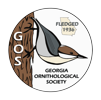Guidelines for Grant Applicants
1) Grant money shall only be used for projects designed to benefit the conservation of bird species, particularly those that reside in Georgia on a seasonal or annual basis, or those that visit stopover habitats in Georgia during migration.
2) This grant source is available only to government agencies and non-profit organizations.
3) Applications on behalf of projects to be funded with these grants should request a minimum of $15,000 from GOS. Applications that feature matching funding are more likely to be supported.
4) Application content should pertain to actual implementation of bird conservation projects “on the ground,” not research projects. Examples of projects that could be funded via this grant source include conducting prescribed burns, implementing exotic species control efforts, relocating or restocking rare species, installing habitat such as nest boxes for non-game species, creating canopy gaps in forests for the benefit of understory-nesting species, planting cover or preferred foods for non-game species, rehabilitating injured wildlife, and installing or repairing water control devices for the benefit of non-game species.
5) The grant will not be used to fund administrative salaries, though it could be used to fund salaries of field staff, and it is not to be used to fund university overhead costs, or indirect costs such as insurance or vehicle maintenance expenses. The Conservation Grants Committee** may ask for receipts for a funded project, and may specify a time period over which the grant money will be released to a recipient. If receipts are less than the grant award, the grant will be limited to the amount actually spent.
6) The typewritten grant application, not to exceed 10 pages, should include a description of the project, list of objectives, criteria for evaluating success of the project, literature citations, an itemized budget, a statement of other financial support, and a brief resume of the applicant. The application deadline each year will be December 31. Grant awards shall be made within 60 days following the deadline.
7) The committee is authorized to determine the amount to be granted per deserving applicant. For example, in some cases there may be only one quality application, and the committee may decide to reward that application with the entire grant budget for that year. In other cases, there may be multiple quality applications, and the committee shall determine how to distribute the grant total among them. If suitable applications are not received, the committee may elect to not award any money in a given calendar year. The total amount available from this grant source in a typical year is $35,000-50,000.
8) At the end of the grant period, the grantee is required to submit to the Conservation Grant Committee a detailed report of project results and grant expenditures.
9) The grant recipient is required to present the results of his or her project at a GOS meeting, as a formal presentation or as a scientific poster, and is encouraged to publish them in The Oriole (if appropriate).
Complete the electronic application (use Microsoft Word to edit the application) and email the completed application to Larry Carlile, l.carlile259@comcast.net.
** Grant applications will be reviewed and evaluated by a five-person committee (i.e., Conservation Grants Committee). The chairperson of this committee shall be appointed by the GOS president. The chairperson shall then appoint four committee members with the concurrence of the president. In the event that there is a conflict of interest involving an applicant and a committee member, the committee member shall recuse himself or herself from the review process for that application. If a committee member must be recused, the chairperson or acting chairperson shall recommend a temporary replacement for the president’s concurrence.
| Year | Recipient and Project |
| 2025 |
Sarah Manning, Birds Georgia Report |
| 2024 |
Brian Wills, The Nature Conservancy |
| 2023 | |
| 2022 |
Chelsea Corbin, The Nature Conservancy Report |
| 2021 | Tim Keyes, Georgia DNR Report |
| 2020 |
Adam Betuel and Gabe Andrle, Atlanta Audubon Society |
| 2019 |
Adam Betuel and Lillie Kline, Atlanta Audubon Society |
| 2018 |
Erick Brown, Malcolm Hodges, and Dan Ryan, The Nature Conservancy |
| 2017 |
Joe Burnham, Georgia DNR |
| 2016 | Tim Keyes, Georgia DNR, Nongame Conservation Section - Report |
| 2015 | Tim Keyes, Georgia DNR, Nongame Conservation Section Malcolm Hodges, The Nature Conservancy: Report |
| 2014 | Ruth Stokes, U.S. Forest Service, Conasauga Ranger District: Report James Cox, Tall Timbers Research Station: Report Nathan Klaus, Georgia DNR, Nongame Conservation Section: Report |
| 2013 | Nathan Klaus, Georgia DNR, Nongame Conservation Section: Report Tami Willadsen, The Nature Conservancy: Report |
| 2012 | Tim Keyes, Georgia DNR, Nongame Conservation Section: Report Atlanta Audubon Society & Georgia IBA Program: Report Nathan Klaus, Georgia DNR, Nongame Conservation Section: Report |
| 2011 | The Nature Conservancy, Georgia Chapter: Report |
| 2010 | The Nature Conservancy, Georgia Chapter: Report Georgia IBA Program: Report |
| 2009 | Jonathan Stober, J.J Ecological Center: Report Tim Keyes & Nathan Klaus, GA DNR, Nongame Conservation Section:Report 1 / Report Supplement |
| 2008 | James Cox, Tall Timbers Research Station: Report GA DNR, Nongame Conservation Section: Report |





